A tree care lesson from the storm
Categories: Uncategorized
Last week’s storm inflicted some serious tree damage in isolated parts of the area. What was most striking at first glance were the number of mature trees that were down, with clean breaks at or near the soil surface. It takes a LOT of wind to produce that kind of damage, more than the weather service reported. What was the deal?
A closer inspection tells the story-or at least the last chapter of the story. Every fallen tree I’ve looked at has had significant decay. After seeing so many examples, my question has become not why so many trees fell, but how have they managed to survive this long?
This red oak that was growing near downtown Stillwater is a great example of the damage. More importantly, it also serves as a stark reminder of the problems that disrupting the root system of a mature tree can cause. Please let this tree be a lesson on two levels. First, please avoid disturbing the soil/roots near trees avoiding at least the area under the dripline. Note that this should be considered a bare minimum area of protection-more would be better. If you have trees where this has been done, inspect them regularly for signs of decline remembering that tree decline usually happens over several years, sometimes after the original disturbance has been long forgotten.
- NOTE: Without getting too deep into it, it’s important to point out that the majority of feeder roots for the tree are in the top 12-18″ of soil and thus in most need of protection. Many of us have mistakenly been taught to believe that a trees root system mirrors it’s top growth. That is untrue. A better analogy would be to think of a wine glass placed in the center of an overturned dinner plate with the wine glass being the tree and the plate being the root system.
Also, give careful consideration to choosing and siting trees appropriately when planting. Trees are a long-term investment and it’s a shame to see this happen if it could have been avoided by selecting a tree better suited for the site. The Payne County Extension Office is more than happy to help you in the selection process.
Also, monitor trees carefully that have had soil work done in the area at some point over the last several years. This could include soil addition or removal, trenching, backhoe, new asphalt or concrete installation, etc.
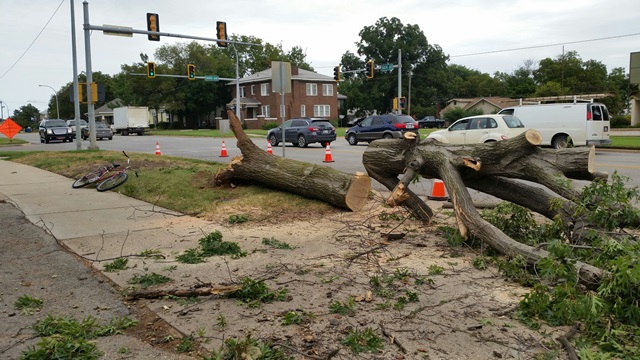
Most of the top of this tree had already been removed by the time I arrived to photograph it. To the average passer-by, it appeared to be relatively healthy with plenty of dark green leaves.
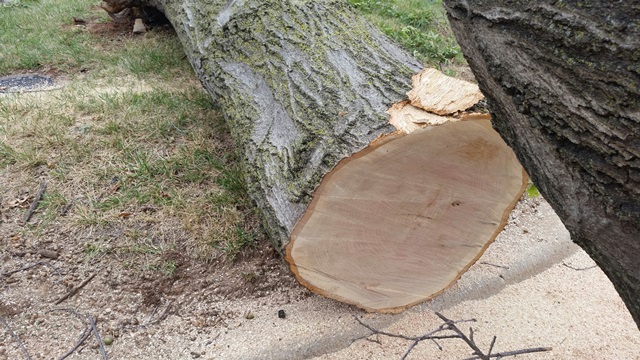
This main trunk is about 18″ in diameter. A cubic foot of red oak weighs about 65 pounds. You can do the math but it’s easy to imagine that a mature tree can inflict a great deal of damage when it falls.
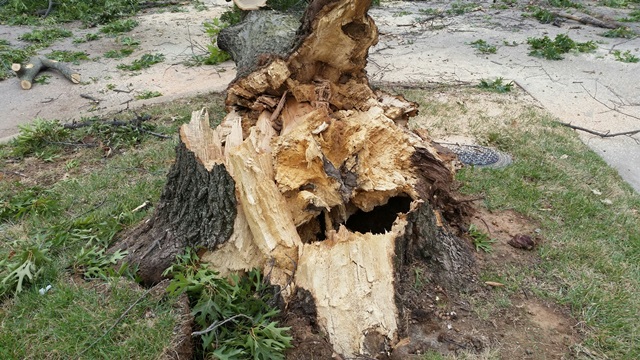
Decay was extensive. The question is not why did it fall but how was it still standing? As you can see, the decay at the base was quite extensive
Note the severe decay in the photo above. Only a small percentage of this trunk had any structural integrity at this point. Much of what you are seeing here was soft to the touch with the wood feeling more like cork than oak. That is what makes the following photo even more difficult to believe….and it also helps to show why it can be so difficult to judge the overall condition of a tree without close examination.
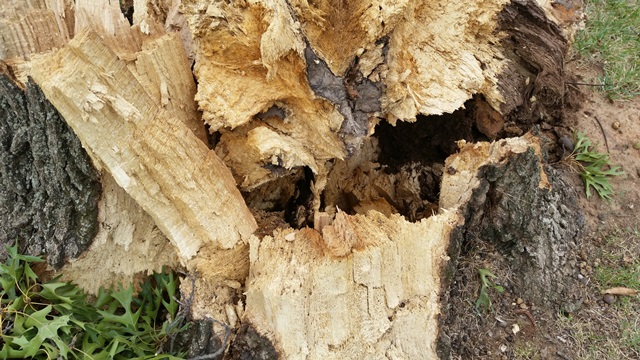
One more close look at the damage. While not apparent in this photo, there was very little remaining wood under the center of the tree below ground level.
I mentioned this being the “last chapter” of this tree’s story. What happened to get it to this point? While I must speculate a bit since I have not watched this tree over its lifetime (I’m old but not that old), there are several clues that help tell the story. As you can see in the top picture, there is asphalt to the left of the sidewalk. This area appears to have been converted from lawn to parking lot at some point, meaning a good percentage of the surface roots would have been damaged/covered in the process. The sidewalk also appears to be newer than much of the neighborhood so it’s possible the tree could have suffered some damage when/if it was reconstructed.
Also, you can also see a meter box located near the base of the tree. There are water lines in the area for sure, and perhaps other utilities as well that have required attention during this trees’ lifetime.
While root disturbance does not automatically mean the premature death of a tree, it should be taken seriously. There are a variety of other factors to be considered including tree species, soil type, micro-climate (what is happening in the environment immediately surrounding the tree), just to name a few.
Trees area multi-generational investment. Often times, things happen that are completely beyond our control when it comes to their long-term health. Understanding these basic principles is an important part of giving our trees their best chance of long-term survival.
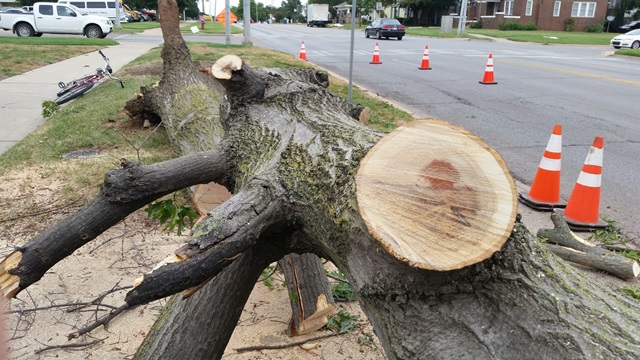
Now I’m really worried we have an oak in our front yard that looks sick.
Can you email me at picture at keith.reed@okstate.edu so I can take a look? If you are a resident of Payne County, I’d also be happy to stop by and look at it in person.
Excellent discussion of the tree and problems the tree.
Gerrit Cuperus
Great job, Keith.